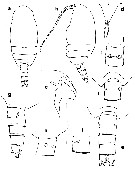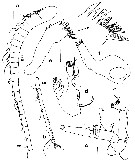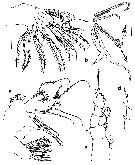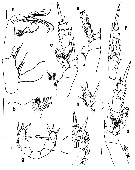|
|
 |
|
Calanoida ( Order ) |
|
|
|
Clausocalanoidea ( Superfamily ) |
|
|
|
Diaixidae ( Family ) |
|
|
|
Thoxancalanus ( Genus ) |
|
|
| |
Thoxancalanus spinatus Markhaseva, Laakmann & Renz, 2013 (2014) (F) | |
| | | | | | | Ref.: | | | Marhhaseva & al., 2014 (p.65, Descr. F, Rem., phylogeny) |  Issued from : E.L. Markhaseva, S. Laakmann & J. Renz in Mar. Biodiv., 2014. [p.65, Fig.1]. Female (from 00°01.2'S, 02°28.7'W): a, habitus (dorsal and lateral, respectively); c, forehead with rostrum (lateral); d, rostrum (anteroventral); e, urosome (dorsal); f, posterior prosome and genital double-somite; g, posterior prosome and urosome (lateral); h-i, posterior prosome and genital double-somite (lateral); j, genital double-somite (ventral). Scale bars: a, b : 0.5 mm; c-i : 0.1 mm. Holotype: a-e, g, h, j; paratype: f. Nota: - Prosome 2.71- 3.3 times as long as urosome. - Rostrum large,as triangular plate with pair of filaments; - Cephalosome and pedigerous somite 1 fused and pedigerous somites 4 and 5 nearly completely fused; posterior corners as short rounded lobes. - Urosome of 4 somites. - Genital double-somite nearly symmetrical , spermathecae astmmetrical in holotype and symmetrical in other specimens. - Caudal rami with 1 dorsal seta, 1 ventral seta and 4 terminal setae. - A1 23-segmented, extending to pedigerous somite 3.
|
 Issued from : E.L. Markhaseva, S. Laakmann & J. Renz in Mar. Biodiv., 2014. [p.67, Fig.2]. Female: a, A1 articulating segments 1-17 (ancestral segmenyts I-XX); b, A1 articulating segments 18-24 (ancestral segments XXI-XXVIII); c, A2; d, Md (palp); Md (gnathobase); f, same (different view). Scale bars: 0.1 mm. Nota: - A2: coxa with 1 seta; basis withy 2 setae; exopod of 8 segments with 1, 1-1-1, 1, 1, 1, 1, 1 and 3 setae; endopodal segment 1 with 2 setae, segment 2 with 8+6 in holotype and 8+7 in paratype. - Md gnathobase without hump, cutting edge with 8 teeth, dorsal setaz and needle-like spinules; basis with 4 setae; exopod 5-segmented with 1, 1, 1, 1 and 2 setae; endopod segment 1 with 3 setae, segment 2 with 9 long setae and additional 1 short seta in paratype.
|
 Issued from : E.L. Markhaseva, S. Laakmann & J. Renz in Mar. Biodiv., 2014. [p.68, Fig.3]. Female: a, Mx1; b, Mx2; c, P1 (anterior view); d, P1 exopod segments 1-3 (lateral spines). Scale bars: 0.1 mm. Paratype: d. Nota: - Mx1: Praecoxal arthrite with 9 terminal, 4 posterior and 1 anterior setae; coxal endite with 5 setae (3 long and 2 small); proximal basal endite with 4 setae, distal basal endite with 5 setae; endopod with 11 setae; exopod with 8 setae; coxal epipodite with 7 long and 2 short setae. - Mx2: Praecoxal endite (previously considered as proximal praecoxal endite) with 5 setae; coxal endite (previously considered as distal praecoxal endite) with 3 setae; basal endites (previously considered as coxal endites) with 3 setae each; enditic-like lobe of proximal endopodal segment (previously considered as proximal basal endite) with 4 setae, 1 is thicker and 1 is sensory; endopod with 3 worm-like, 5 brush-like sensory and 1 small sclerotized setae. - P1: coxa without medial seta; basis with medial distal seta curved withn setules; endopod 1-segmented with lateral lobe with spinules; exopod segment 1 to 3 with 1 lateral spine each, spines of segments 1 and 2 shorter than spine of segment 3.
|
 Issued from : E.L. Markhaseva, S. Laakmann & J. Renz in Mar. Biodiv., 2014. [p.69, Fig.4]. Female: a, Mxp; b, Mxp coxal endite; c, P2 (posterior view); d, P3 (posterior view); e, P4 coxa, basis, exopod segment 1 and endopod (posterior view); f, P4 exopod segments 2-3 (posterior view); g, P5; h, P5 exopod. Scale bars: 0.1 mm. Holotype: a-e, g; paratype: f, h. Nota: - Mxp: Syncoxa with 1 partly sensory seta on proximal praecoxal endite (previously considered as praecoxal endite), 2 setae (of them 1 partly sensory seta) on middle praecoxal endite (previously considered as proximal coxal endite) and 2 sclerotized setae and 1 poorly developed brush-like seta on distal praecoxal endite (previously considered as middle coxal endite); coxal endite (corresponds to the distal coxal endite of Huys & Boxshall, 1991) with 3 setae and small rounded attenuation. Basis with 3 proxuimal and 2 distal setae. Endopod 5-segmented with 4, 4, 3, 3+1, and 4 setae. - P5 3-segmented; coxa naked, basis with lateral scale-like spinules, 3rd segment ornamented with scale-like spinules, 3 unequal articulated distal spines and 1 articulated medial spine longest.
| | | | | NZ: | 2 | | |
|
Distribution map of Thoxancalanus spinatus by geographical zones
|
| | | | Loc: | | | S Atlantic (Brasilian Basin), Atlantic (equatorial), N Atlantic (W Canary Basin).
Type locality: 00°01.2'S, 02°28.7'W. | | | | N: | 1 | | | | Lg.: | | | (1142) F: 3,75-3,80; {F: 3,75-3,80} | | | | Rem.: | Above the sea bed (depth: 5058 m, 5148 m, 4338 m).
After Markhaseva & al. (2014,p.66) ,some morphological differences have been observed: 1- the genital double-somite shows more asymmetry in the holotype than in other specimens; 2- in the holotype the distal part of the left spermatheca is more prolonged and turned anteriorly, than in the right one (versus spermathecae are nearly symmetrical in other specimens); 3- ancestral segments X and XI of A1 have traces of fusion visible in holotype (vs not visible in other specimens) | | | Last update : 16/12/2021 | |
|
|
 Any use of this site for a publication will be mentioned with the following reference : Any use of this site for a publication will be mentioned with the following reference :
Razouls C., Desreumaux N., Kouwenberg J. and de Bovée F., 2005-2025. - Biodiversity of Marine Planktonic Copepods (morphology, geographical distribution and biological data). Sorbonne University, CNRS. Available at http://copepodes.obs-banyuls.fr/en [Accessed December 27, 2025] © copyright 2005-2025 Sorbonne University, CNRS
|
|
 |
 |







